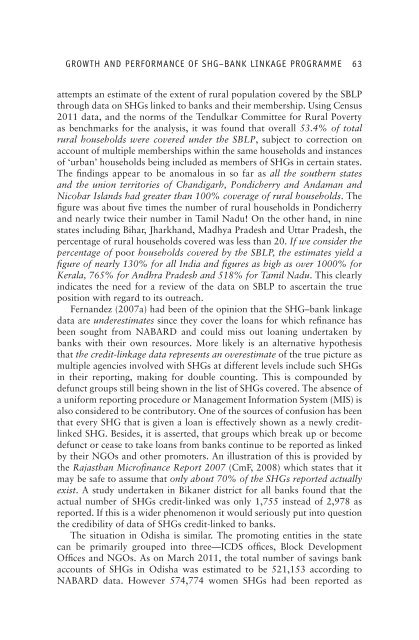Banking on SHGs - Nabard
Banking on SHGs - Nabard
Banking on SHGs - Nabard
- No tags were found...
Create successful ePaper yourself
Turn your PDF publications into a flip-book with our unique Google optimized e-Paper software.
Growth and Performance of SHG–Bank Linkage Programme 63attempts an estimate of the extent of rural populati<strong>on</strong> covered by the SBLPthrough data <strong>on</strong> <strong>SHGs</strong> linked to banks and their membership. Using Census2011 data, and the norms of the Tendulkar Committee for Rural Povertyas benchmarks for the analysis, it was found that overall 53.4% of totalrural households were covered under the SBLP, subject to correcti<strong>on</strong> <strong>on</strong>account of multiple memberships within the same households and instancesof ‘urban’ households being included as members of <strong>SHGs</strong> in certain states.The findings appear to be anomalous in so far as all the southern statesand the uni<strong>on</strong> territories of Chandigarh, P<strong>on</strong>dicherry and Andaman andNicobar Islands had greater than 100% coverage of rural households. Thefigure was about five times the number of rural households in P<strong>on</strong>dicherryand nearly twice their number in Tamil Nadu! On the other hand, in ninestates including Bihar, Jharkhand, Madhya Pradesh and Uttar Pradesh, thepercentage of rural households covered was less than 20. If we c<strong>on</strong>sider thepercentage of poor households covered by the SBLP, the estimates yield afigure of nearly 130% for all India and figures as high as over 1000% forKerala, 765% for Andhra Pradesh and 518% for Tamil Nadu. This clearlyindicates the need for a review of the data <strong>on</strong> SBLP to ascertain the truepositi<strong>on</strong> with regard to its outreach.Fernandez (2007a) had been of the opini<strong>on</strong> that the SHG–bank linkagedata are underestimates since they cover the loans for which refinance hasbeen sought from NABARD and could miss out loaning undertaken bybanks with their own resources. More likely is an alternative hypothesisthat the credit-linkage data represents an overestimate of the true picture asmultiple agencies involved with <strong>SHGs</strong> at different levels include such <strong>SHGs</strong>in their reporting, making for double counting. This is compounded bydefunct groups still being shown in the list of <strong>SHGs</strong> covered. The absence ofa uniform reporting procedure or Management Informati<strong>on</strong> System (MIS) isalso c<strong>on</strong>sidered to be c<strong>on</strong>tributory. One of the sources of c<strong>on</strong>fusi<strong>on</strong> has beenthat every SHG that is given a loan is effectively shown as a newly creditlinkedSHG. Besides, it is asserted, that groups which break up or becomedefunct or cease to take loans from banks c<strong>on</strong>tinue to be reported as linkedby their NGOs and other promoters. An illustrati<strong>on</strong> of this is provided bythe Rajasthan Microfinance Report 2007 (CmF, 2008) which states that itmay be safe to assume that <strong>on</strong>ly about 70% of the <strong>SHGs</strong> reported actuallyexist. A study undertaken in Bikaner district for all banks found that theactual number of <strong>SHGs</strong> credit-linked was <strong>on</strong>ly 1,755 instead of 2,978 asreported. If this is a wider phenomen<strong>on</strong> it would seriously put into questi<strong>on</strong>the credibility of data of <strong>SHGs</strong> credit-linked to banks.The situati<strong>on</strong> in Odisha is similar. The promoting entities in the statecan be primarily grouped into three—ICDS offices, Block DevelopmentOffices and NGOs. As <strong>on</strong> March 2011, the total number of savings bankaccounts of <strong>SHGs</strong> in Odisha was estimated to be 521,153 according toNABARD data. However 574,774 women <strong>SHGs</strong> had been reported as














